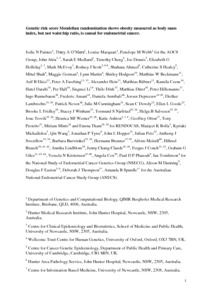Painter, JN;
O'Mara, TA;
Marquart, L;
Webb, PM;
Attia, J;
Medland, SE;
Cheng, T;
Dennis, J;
Holliday, EG;
McEvoy, M;
et al.
Painter, JN; O'Mara, TA; Marquart, L; Webb, PM; Attia, J; Medland, SE; Cheng, T; Dennis, J; Holliday, EG; McEvoy, M; Scott, RJ; Ahmed, S; Healey, CS; Shah, M; Gorman, M; Martin, L; Hodgson, SV; Beckmann, MW; Ekici, AB; Fasching, PA; Hein, A; Rübner, M; Czene, K; Darabi, H; Hall, P; Li, J; Dörk, T; Dürst, M; Hillemanns, P; Runnebaum, IB; Amant, F; Annibali, D; Depreeuw, J; Lambrechts, D; Neven, P; Cunningham, JM; Dowdy, SC; Goode, EL; Fridley, BL; Winham, SJ; Njølstad, TS; Salvesen, HB; Trovik, J; Werner, HMJ; Ashton, KA; Otton, G; Proietto, A; Mints, M; Tham, E; Bolla, MK; Michailidou, K; Wang, Q; Tyrer, JP; Hopper, JL; Peto, J; Swerdlow, AJ; Burwinkel, B; Brenner, H; Meindl, A; Brauch, H; Lindblom, A; Chang-Claude, J; Couch, FJ; Giles, GG; Kristensen, VN; Cox, A; Pharoah, PDP; Tomlinson, I; Dunning, AM; Easton, DF; Thompson, DJ; Spurdle, AB; AOCS Group; for RENDOCAS; National Study of Endometrial Cancer Genetics Group (NSECG); Australian National Endometrial Cancer Study Group (ANECS)
(2016)
Genetic Risk Score Mendelian Randomization Shows that Obesity Measured as Body Mass Index, but not Waist:Hip Ratio, Is Causal for Endometrial Cancer.
Cancer Epidemiol Biomarkers Prev, 25 (11).
pp. 1503-1510.
ISSN 1538-7755
https://doi.org/10.1158/1055-9965.EPI-16-0147
SGUL Authors: Hodgson, Shirley Victoria
![[img]](https://openaccess.sgul.ac.uk/113823/1.hassmallThumbnailVersion/Painter_et_al-2016-Cancer_Epidemiology_Biomarkers_and_Prevention-AM.pdf)  Preview |
|
PDF
Published Version
Available under License ["licenses_description_publisher" not defined].
Download (1MB)
| Preview
|
Abstract
BACKGROUND: The strongest known risk factor for endometrial cancer is obesity. To determine whether SNPs associated with increased body mass index (BMI) or waist-hip ratio (WHR) are associated with endometrial cancer risk, independent of measured BMI, we investigated relationships between 77 BMI and 47 WHR SNPs and endometrial cancer in 6,609 cases and 37,926 country-matched controls. METHODS: Logistic regression analysis and fixed effects meta-analysis were used to test for associations between endometrial cancer risk and (i) individual BMI or WHR SNPs, (ii) a combined weighted genetic risk score (wGRS) for BMI or WHR. Causality of BMI for endometrial cancer was assessed using Mendelian randomization, with BMIwGRS as instrumental variable. RESULTS: The BMIwGRS was significantly associated with endometrial cancer risk (P = 3.4 × 10-17). Scaling the effect of the BMIwGRS on endometrial cancer risk by its effect on BMI, the endometrial cancer OR per 5 kg/m2 of genetically predicted BMI was 2.06 [95% confidence interval (CI), 1.89-2.21], larger than the observed effect of BMI on endometrial cancer risk (OR = 1.55; 95% CI, 1.44-1.68, per 5 kg/m2). The association attenuated but remained significant after adjusting for BMI (OR = 1.22; 95% CI, 1.10-1.39; P = 5.3 × 10-4). There was evidence of directional pleiotropy (P = 1.5 × 10-4). BMI SNP rs2075650 was associated with endometrial cancer at study-wide significance (P < 4.0 × 10-4), independent of BMI. Endometrial cancer was not significantly associated with individual WHR SNPs or the WHRwGRS. CONCLUSIONS: BMI, but not WHR, is causally associated with endometrial cancer risk, with evidence that some BMI-associated SNPs alter endometrial cancer risk via mechanisms other than measurable BMI. IMPACT: The causal association between BMI SNPs and endometrial cancer has possible implications for endometrial cancer risk modeling. Cancer Epidemiol Biomarkers Prev; 25(11); 1503-10. ©2016 AACR.
| Item Type: |
Article
|
| Additional Information: |
This manuscript has been accepted for publication in
Cancer Epidemiology, Biomarkers and Prevention, which is published by the American Association for Cancer Research. |
| Keywords: |
Body Mass Index, Endometrial Neoplasms, Female, Genetic Predisposition to Disease, Humans, Mendelian Randomization Analysis, Obesity, Polymorphism, Single Nucleotide, Waist-Hip Ratio, AOCS Group, for RENDOCAS, National Study of Endometrial Cancer Genetics Group (NSECG), Australian National Endometrial Cancer Study Group (ANECS), Humans, Endometrial Neoplasms, Obesity, Genetic Predisposition to Disease, Body Mass Index, Waist-Hip Ratio, Polymorphism, Single Nucleotide, Female, Mendelian Randomization Analysis, 11 Medical and Health Sciences, Epidemiology |
| SGUL Research Institute / Research Centre: |
Academic Structure > Molecular and Clinical Sciences Research Institute (MCS) |
| Journal or Publication Title: |
Cancer Epidemiol Biomarkers Prev |
| ISSN: |
1538-7755 |
| Language: |
eng |
| Dates: |
| Date | Event |
|---|
| November 2016 | Published | | 22 August 2016 | Published Online | | 15 June 2016 | Accepted |
|
| Publisher License: |
Publisher's own licence |
| Projects: |
|
| PubMed ID: |
27550749 |
| Web of Science ID: |
WOS:000387537000007 |
 |
Go to PubMed abstract |
| URI: |
https://openaccess.sgul.ac.uk/id/eprint/113823 |
| Publisher's version: |
https://doi.org/10.1158/1055-9965.EPI-16-0147 |
Statistics
Item downloaded times since 04 Nov 2021.
Actions (login required)
 |
Edit Item |



